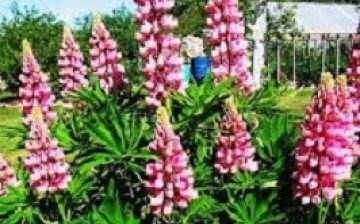Growing perennial lupine
Lupine is a very beautiful herbaceous plant. There are more than 200 species of lupine, among which there are both annuals and perennials.
Three types are most popular with florists: yellow, white and narrow-leaved. Among perennial species, Lpolyphyllus is the most widespread.
The height of perennial lupine can reach one and a half meters. Lupine flowers are collected in a brush, the length of which can be about 50 centimeters.
Growing perennial lupine on your site is not difficult, since the plant is unpretentious. Although some growing conditions must be observed.
A sunny location is most suitable. In the shade, perennial lupine can also grow, but under such conditions, the duration of flowering is reduced.
Any soil is suitable for lupine, with the exception of heavy loamy substrates and peat soils. You also need to know that excessive moisture can only harm the plant.
Proper cultivation of perennial lupine will ensure beautiful, abundant and long-lasting flowering throughout the summer.
Lupine is propagated by seeds that are sown at any time except during the cold winter period. When sowing, keep the distance between plants about half a meter. As a rule, in the first year, lupine forms only a powerful stem with leaves, and beautiful inflorescences appear only in the second year. In this case, the color of perennial lupine inflorescences can be cream, pink, blue, red and burgundy. There are also two-tone lupins.




I would not say that lupine blooms all summer, in St. Petersburg it bloomed around mid-June, but it will soon fade and be rather ugly - tall stems with large pods with seeds. I always cut them off so that they don't scatter. Otherwise, it will turn into a problem.